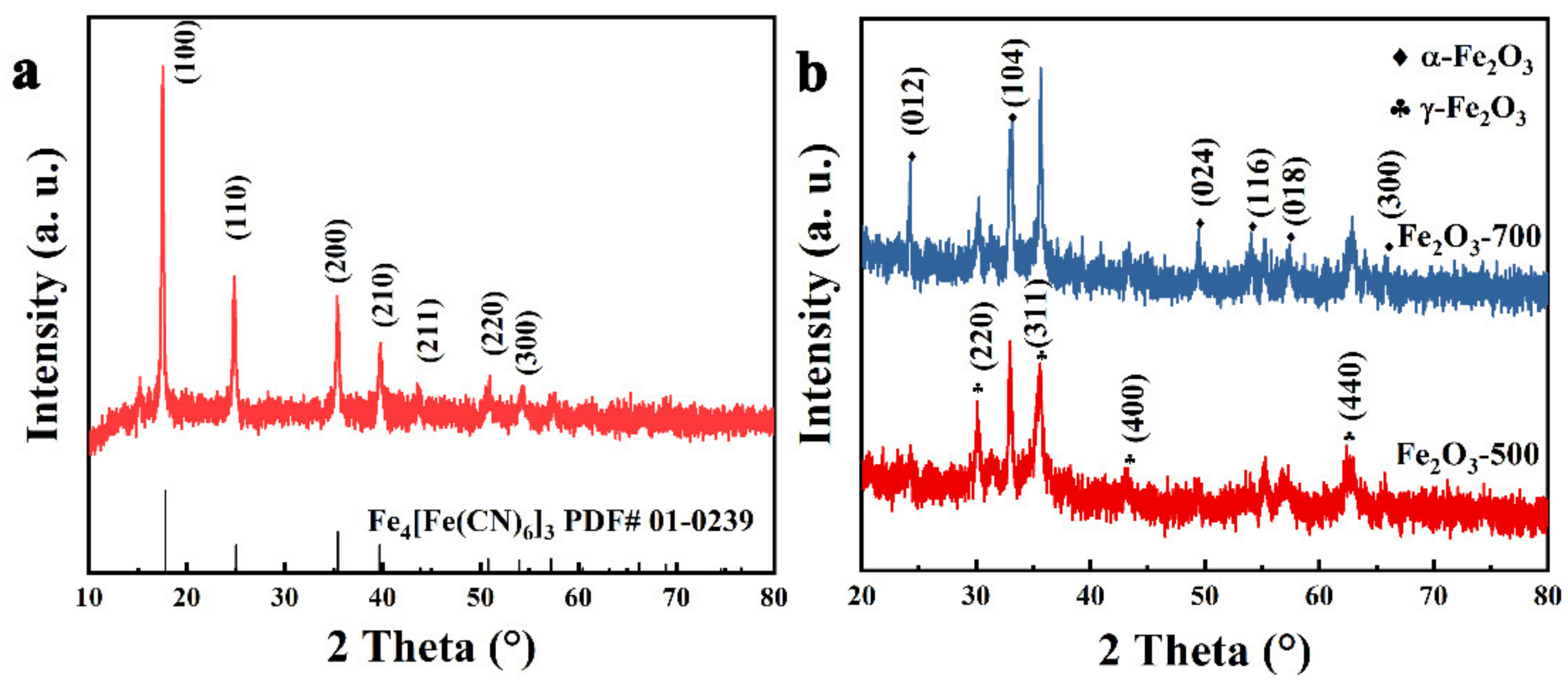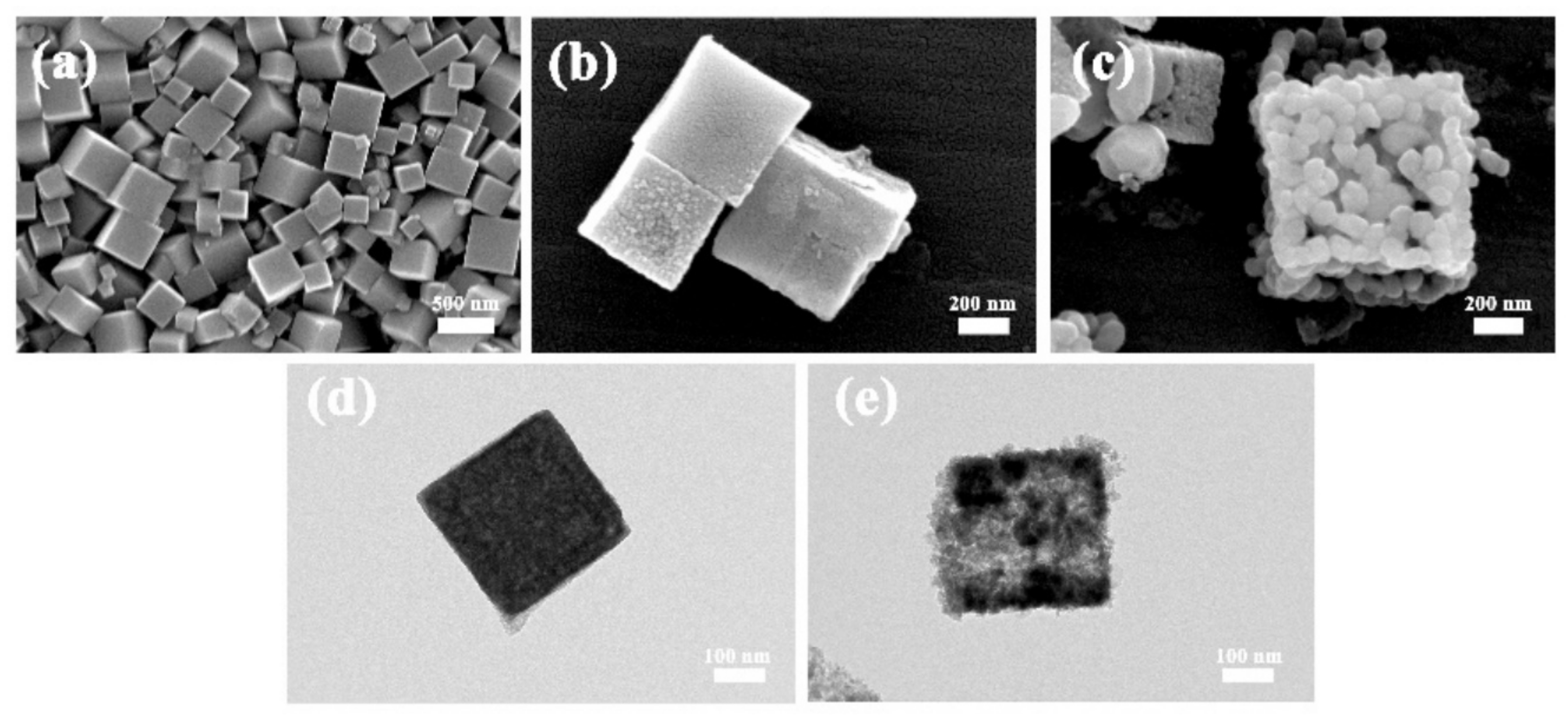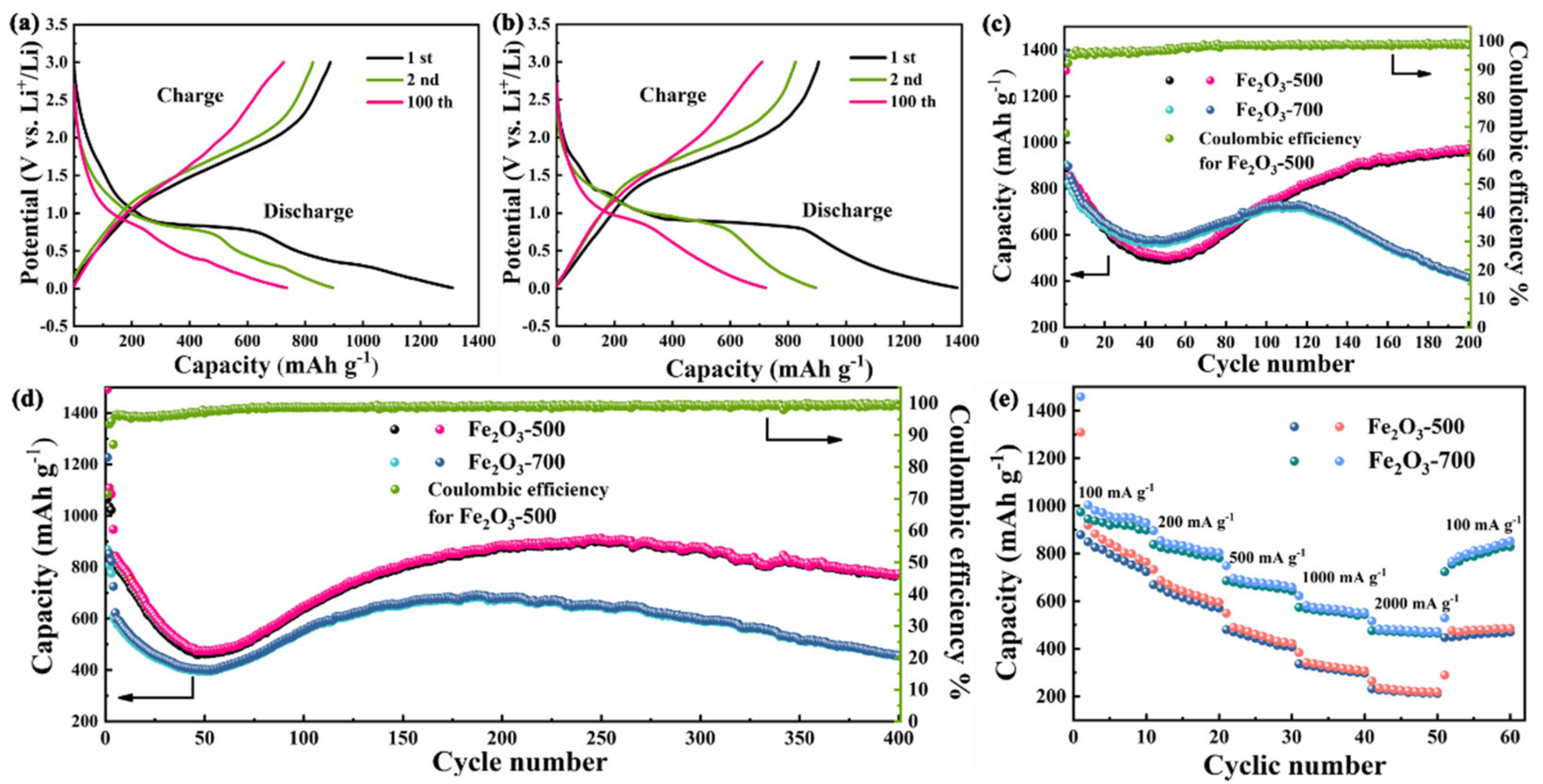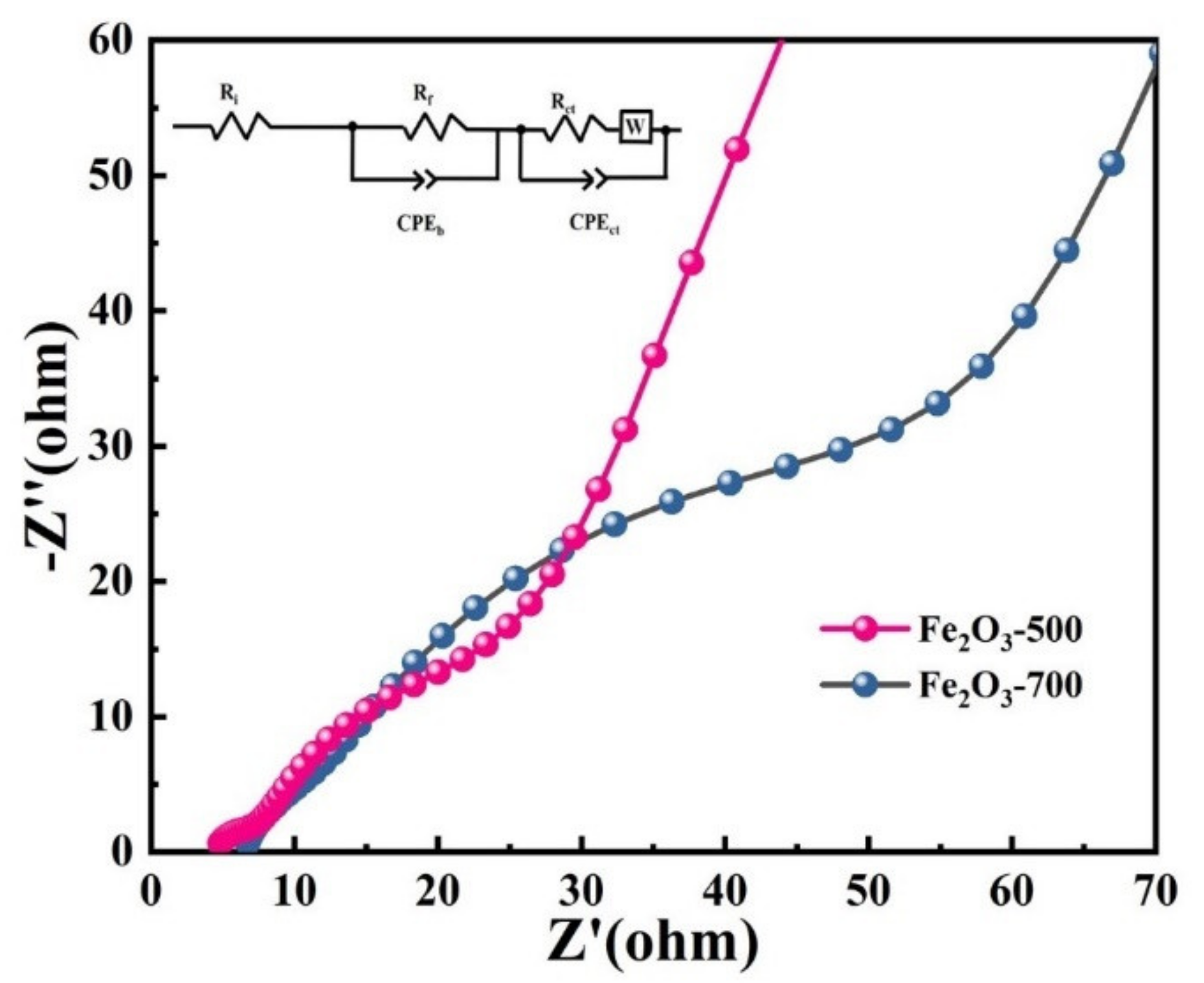Fe2O3 Microcubes Derived from Metal–Organic Frameworks for Lithium-Ion Storage with Excellent Performance
Abstract
:1. Introduction
2. Materials and Methods
2.1. Synthesis of Fe2O3 Microcubes
2.2. Characterization
3. Results and Discussion
4. Conclusions
- (1)
- Fe2O3 microcubes electrode obtained by the calcination process at 500 °C exhibited superior electrochemical performances than that of Fe2O3 obtained by the calcination process at 700 °C. The increase in calcination temperature will lead to the further sintering reaction between the particles and the formation of cracks and voids in crystals that eventually lead to the breakup of microcube and thus lower stable structure of Fe2O3 microcubes electrode.
- (2)
- For Fe2O3 microcubes obtained by the calcination process at 500 °C, the discharge capacity is 974.7 mAh g−1 after 200 cycles, and the specific discharge capacity is 775.1 mAh g−1 at 1000 mA g−1 current density after 400 cycles.
- (3)
- Fe2O3 microcubes prepared by precipitation method combined with appropriate heat treatment conditions exhibits an excellent/stable lithium storage performance, and hence is a promising anode material for LIBs.
Supplementary Materials
Author Contributions
Funding
Institutional Review Board Statement
Informed Consent Statement
Data Availability Statement
Conflicts of Interest
References
- Xia, S.B.; Yan, Y.X.; Huang, W.J.; Yang, R.M.; Suo, H.B.; Liu, J.M.; Cheng, F.X.; Liu, J.J. In-situ synthesis of nanocomposite from metal-organic frameworks template for high-performance rechargeable batteries. J. Power Sources 2020, 464, 228247. [Google Scholar] [CrossRef]
- Xu, C.F.; Zhang, K.W.; Zhang, D.; Chang, S.L.; Liang, F.; Yan, P.F.; Yao, Y.C.; Qu, T.; Zhan, J.; Ma, W.H. Reversible hybrid sodium-CO2 batteries with low charging voltage and long-life. Nano Energy 2020, 68, 104318. [Google Scholar] [CrossRef]
- Zhu, Z.Y.; Liang, F.; Zhou, Z.R.; Zeng, X.Y.; Wang, D.; Dong, P.; Zhao, J.B.; Sun, S.G.; Zhang, Y.J.; Li, X. Expanded biomass-derived hard carbon with ultra-stable performance in sodium-ion batteries. J. Mate. Chem. A 2018, 6, 1513–1522. [Google Scholar] [CrossRef]
- Liu, J.M.; Lu, Y.H.; Xu, Z.F.; Wang, R.X.; Yan, H.C.; Li, X. Effect of citric acid-to-nitrate ratio on combustion synthesis of CuFe2O4 for sodium-ion storage. J. Mater. Sci. Mater. Electron. 2021, 32, 94–101. [Google Scholar] [CrossRef]
- Liu, J.M.; Lu, Y.H.; Wang, R.X.; Xu, Z.F.; Li, X. Simple and Efficient Combustion Method for Preparation of High-Performance Co3O4 Anode Materials for Lithium-ion Batteries. JOM 2020, 72, 3296–3302. [Google Scholar] [CrossRef]
- Tang, L.B.; Liu, Y.; Wei, H.X.; Yan, C.; He, Z.J.; Li, Y.J.; Zheng, J.C. Boosting cell performance of LiNi0.8Co0.1Mn0.1O2 cathode material via structure design. J. Energy Chem. 2021, 55, 114–123. [Google Scholar] [CrossRef]
- Xu, X.J.; Liu, J.; Hu, R.Z.; Liu, J.W.; Ouyang, L.Z.; Zhu, M. Self-supported CoP nanorod arrays grafted on stainless steel as an advanced integrated anode for stable and long-life lithium-ion batteries. Chem. Eur. J. 2017, 23, 5198–5204. [Google Scholar] [CrossRef] [PubMed]
- Bhatt, M.D.; Lee, J.Y. High capacity conversion anodes in Li-ion batteries: A review. Int. J. Hydrog. Energy 2019, 44, 10852–10905. [Google Scholar] [CrossRef]
- Zhao, Y.; Li, X.F.; Yan, B.; Xiong, D.B.; Li, D.J.; Lawes, S.; Sun, X.L. Recent developments and understanding of novel mixed transition-metal oxides as anodes in lithium Ion batteries. Adv. Energy Mater. 2016, 6, 1502175. [Google Scholar] [CrossRef]
- Yu, S.H.; Lee, S.H.; Lee, D.J.; Sung, Y.E.; Hyeon, T. Conversion reaction-based oxide nanomaterials for lithium ion battery anodes. Small 2016, 12, 2146–2172. [Google Scholar] [CrossRef]
- Xue, Z.; Li, L.L.; Cao, L.J.; Zheng, W.Z.; Yang, W.; Yu, X.W. A simple method to fabricate NiFe2O4/NiO@Fe2O3 core-shelled nanocubes based on Prussian blue analogues for lithium ion battery. J. Alloy Compd. 2020, 825, 153966. [Google Scholar] [CrossRef]
- Zheng, Z.M.; Li, P.; Huang, J.S.; Liu, H.D.; Zao, Y.; Hu, Z.L.; Zhang, L.; Chen, H.X.; Wang, M.S.; Peng, D.L. High performance columnar-like Fe2O3@carbon composite anode via yolk@shell structural design. J. Energy Chem. 2020, 41, 126–134. [Google Scholar] [CrossRef] [Green Version]
- Hu, X.S.; Lou, X.B.; Li, C.; Yang, Q.; Chen, Q.; Hu, B.W. Green and rational design of 3D layer-by-layer MnOx hierarchically mesoporous microcuboids from MOF templates for high-rate and long-life Li-Ion batteries. ACS Appl. Mater. Interfaces 2018, 10, 14684–14697. [Google Scholar] [CrossRef]
- Dubal, D.P.; Jayaramulu, K.; Sunil, J.; Kment, Š.; Gomez-Romero, P.; Narayana, C.; Zbořil, R.; Fischer, R.D. Metal–Organic Framework (MOF) Derived Electrodes with Robust and Fast Lithium Storage for Li-Ion Hybrid Capacitors. Adv. Funct. Mater. 2019, 29, 1900532. [Google Scholar] [CrossRef]
- Zhao, G.F.; Zhang, Y.H.; Gao, Z.H.; Li, H.N.; Liu, S.M.; Cai, S.; Yang, X.F.; Guo, H.; Sun, X.L. Dual active site of the Azo and carbonyl-modified covalent organic framework for high-performance Li storage. ACS Energy Lett. 2020, 5, 1022–1031. [Google Scholar] [CrossRef]
- Peng, H.J.; Hao, G.X.; Chu, Z.H.; Lin, J.; Lin, X.M.; Cai, Y.P. Mesoporous Mn3O4/C microspheres fabricated from MOF template as advanced lithium-ion battery anode. Cryst. Growth Des. 2017, 17, 5881–5886. [Google Scholar] [CrossRef]
- Yang, S.J.; Nam, S.; Kim, T.; Im, J.H.; Jung, H.; Kang, J.H.; Wi, S.; Park, B.; Park, C.R. Preparation and exceptional lithium anodic performance of porous carbon-coated ZnO quantum dots derived from a metal–organic framework. J. Am. Chem. Soc. 2013, 135, 7394–7397. [Google Scholar] [CrossRef]
- Lu, Y.H.; Li, J.H.; Xu, Z.F.; Liu, J.M.; Liu, S.J.; Wang, R.X. Metal–organic framework derived porous nanostructured Co3O4 as high-performance anode materials for lithium-ion batteries. J. Mater. Sci. 2021, 56, 2451–2463. [Google Scholar] [CrossRef]
- Banerjee, A.; Aravindan, V.; Bhatnagar, S.; Mhamane, D.; Madhavi, S.; Ogale, S. Superior lithium storage properties of α-Fe2O3 nano-assembled spindles. Nano Energy 2013, 2, 890–896. [Google Scholar] [CrossRef]
- Xu, X.; Cao, R.; Jeong, S.; Cho, J. Spindle-like mesoporous α-Fe2O3 anode material prepared from MOF template for high-rate lithium batteries. Nano Lett. 2012, 12, 4988–4991. [Google Scholar] [CrossRef] [PubMed]
- Guo, W.X.; Sun, W.W.; Lv, L.P.; Kong, S.F.; Wang, Y. Microwave-assisted morphology evolution of Fe-based metal–organic frameworks and their derived Fe2O3 nanostructures for Li-ion storage. ACS Nano 2017, 11, 4198–4205. [Google Scholar] [CrossRef]
- He, X.; Tian, L.; Qiao, M.; Zhang, J.; Geng, W.; Zhang, Q. A novel highly crystalline Fe4(Fe(CN)6)3 concave cube anode material for Li-ion batteries with high capacity and long life. J. Mater. Chem. A 2019, 7, 11478–11486. [Google Scholar] [CrossRef]
- Hu, L.; Yan, N.; Chen, Q.; Zhang, P.; Zhong, H.; Zheng, X.; Li, Y.; Hu, X. Fabrication based on the kirkendall effect of Co3O4 porous nanocages with extraordinarily high capacity for lithium storage. Chem. Eur. J. 2012, 18, 8971–8977. [Google Scholar] [CrossRef]
- Huang, Y.; Li, Y.W.; Huang, R.S.; Yao, J.H. Ternary Fe2O3/Fe3O4/FeCO3 composite as a high-performance anode material for lithium-ion batteries. J. Phys. Chem. C 2019, 123, 12614–12622. [Google Scholar] [CrossRef]
- Zheng, Z.M.; Zao, Y.; Zhang, Q.B.; Cheng, Y.; Chen, H.X.; Zhang, K.L.; Wang, M.S.; Peng, D.L. Robust erythrocyte-like Fe2O3@carbon with yolk-shell structures as high-performance anode for lithium ion batteries. Chem. Eng. J. 2018, 347, 563–573. [Google Scholar] [CrossRef]
- Jiang, T.C.; Bu, F.X.; Feng, X.X.; Shakir, I.; Hao, G.L.; Xu, Y.X. Porous Fe2O3 nanoframeworks encapsulated within three-dimensional graphene as high-performance flexible anode for lithium-ion battery. ACS Nano 2017, 11, 5140–5147. [Google Scholar] [CrossRef] [PubMed]
- Luo, S.H.; Hu, D.B.; Liu, H.; Li, J.Z.; Yi, T.F. Hydrothermal synthesis and characterization of α-Fe2O3/C using acid-pickled iron oxide red for Li-ion batteries. J. Hazard. Mater. 2019, 368, 714–721. [Google Scholar] [CrossRef] [PubMed]
- Fan, H.H.; Zhou, L.; Li, H.H.; Fan, C.Y.; Wu, X.L.; Zhang, J.P. 2D Fe2O3 nanosheets with bi-continuous pores inherited from Fe-MOF precursors: An advanced anode material for Li-ion half/full batteries. 2D Mater. 2019, 6, 045022. [Google Scholar] [CrossRef]





| Parameters | Fe2O3-500 | Fe2O3-700 |
|---|---|---|
| Rs (Ω) | 4.61 | 6.54 |
| Rf (Ω) | 2.73 | 6.16 |
| Rct (Ω) | 29.7 | 57.7 |
Publisher’s Note: MDPI stays neutral with regard to jurisdictional claims in published maps and institutional affiliations. |
© 2021 by the authors. Licensee MDPI, Basel, Switzerland. This article is an open access article distributed under the terms and conditions of the Creative Commons Attribution (CC BY) license (https://creativecommons.org/licenses/by/4.0/).
Share and Cite
Zhong, C.; Liu, J.; Lu, Y.; Zhang, H. Fe2O3 Microcubes Derived from Metal–Organic Frameworks for Lithium-Ion Storage with Excellent Performance. Crystals 2021, 11, 854. https://doi.org/10.3390/cryst11080854
Zhong C, Liu J, Lu Y, Zhang H. Fe2O3 Microcubes Derived from Metal–Organic Frameworks for Lithium-Ion Storage with Excellent Performance. Crystals. 2021; 11(8):854. https://doi.org/10.3390/cryst11080854
Chicago/Turabian StyleZhong, Caini, Jiaming Liu, Yanhua Lu, and Haihui Zhang. 2021. "Fe2O3 Microcubes Derived from Metal–Organic Frameworks for Lithium-Ion Storage with Excellent Performance" Crystals 11, no. 8: 854. https://doi.org/10.3390/cryst11080854
APA StyleZhong, C., Liu, J., Lu, Y., & Zhang, H. (2021). Fe2O3 Microcubes Derived from Metal–Organic Frameworks for Lithium-Ion Storage with Excellent Performance. Crystals, 11(8), 854. https://doi.org/10.3390/cryst11080854





